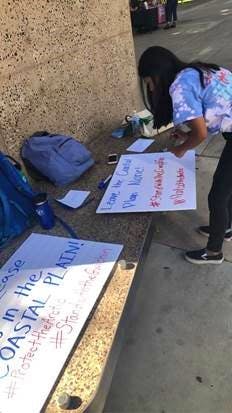As I walked to Biology 101 my freshman year at Clemson University, a poster with a photo of a tiger caught my eye. It said “Only 3,200 remain” across the cat’s eyes like a blindfold. “Save our mascot.” Curious, I went to the meeting advertised at the bottom, ended up joining a tiger conservation student organization, and spent my undergraduate years learning about the plight of wild tigers and advocating for better treatment in captivity. That poster even led to a master’s thesis that allowed me to travel to Kanha National Park in India to study human-tiger conflict. Through countless presentations, pie-in-the-face fundraising events, creative inquiry classes and lobbying trips to D.C., I saw the incredible power of youth advocacy and organizing firsthand and the impact I was having on conservation. Now that I’m working at Defenders of Wildlife, I want to enable students across the country to grow into their own wildlife advocacy roles through our campus clubs.
Young people have always been shaping our world, and the recent rise of youth-led movements such as March for Our Lives, Sunrise Movement and Black Lives Matter are no different. Young environmental activists like Greta Thunberg and Amariyanna Copeny, “Little Miss Flint,” are turning the heads of decision-makers as young people fearlessly dominate the news by holding elected officials accountable for creating a safer and healthier future.



Defenders is committed to empowering the energy, passion and innovation of young people by bringing their voices to the table and engaging with new and diverse constituencies across the country. Last year, Defenders sponsored student-led, wildlife-focused campus clubs in Arizona, Colorado, Maine and Pennsylvania. Deanna Noël, director of outreach at Defenders of Wildlife, wrote this on the importance of youth engagement, “Young people are crucial to mobilize in the face of the extinction crisis and threats to the future of planet Earth. Young people are rising up, and those who are entering or are in college comprise the bulk of new voters.”
These clubs provide a launch pad for youth advocates and budding environmental leaders to enter the world of federal policy advocacy. Each student group is empowered to choose its own campaign based on the group’s interests and Defenders’ federal advocacy agenda, leading campaigns from opposing drilling in the Arctic National Wildlife Refuge and fighting harmful rollbacks to the Endangered Species Act to standing against the construction of the Trump administration’s damaging border wall and urging law makers to support protections for the critically endangered North Atlantic right whale. Students learn the ropes of effective grassroots lobbying through writing letters to the editor, petitioning, hosting events, meeting with members of Congress and building coalitions with other student groups. Most recently, many of our campus leaders participated in Defenders’ annual lobby day, done virtually this year, leading 15 meetings in one day with their elected officials.
I am reminded of a beautiful Instagram post from International Women’s Day, where there was a loop of women rising up, each woman getting pulled up, then helping the woman who pulled her up get to the next level, over and over. The caption was, “We rise by lifting others.” It just feels right after being empowered through a conservation student organization to pursue conservation advocacy as a career and find myself helping other students find their voices as well.
Ready to make a difference? Visit defenders.org/campus-clubs to find your club.






Follow Defenders of Wildlife
facebook bluesky twitter instagram youtube tiktok threads linkedin